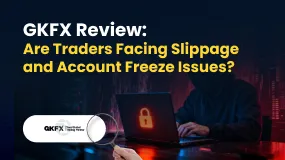简体中文
繁體中文
English
Pусский
日本語
ภาษาไทย
Tiếng Việt
Bahasa Indonesia
Español
हिन्दी
Filippiiniläinen
Français
Deutsch
Português
Türkçe
한국어
العربية
From Rookie to Pro: Becoming a Confident Trader
Abstract:Trading in the financial markets, whether forex or cryptocurrency, can seem daunting for beginners. However, with the right approach and mindset, anyone can evolve from a rookie to a confident trader. Here’s a step-by-step guide to help you navigate this journey.

Trading in the financial markets, whether forex or cryptocurrency, can seem daunting for beginners. However, with the right approach and mindset, anyone can evolve from a rookie to a confident trader. Heres a step-by-step guide to help you navigate this journey.

1. Education and Research
The first step to becoming a successful trader is education. Understanding the basics of forex and cryptocurrency markets is crucial. Familiarize yourself with key concepts such as pips, leverage, margin, and different types of orders. Utilize online resources, books, and courses to build a solid foundation. Some essential resources include books like “Currency Trading for Dummies” by Kathleen Brooks and Brian Dolan. Online courses on platforms like Coursera and Udemy offer comprehensive courses on forex and cryptocurrency trading. Additionally, participating in webinars and seminars hosted by experienced traders can provide valuable insights and practical knowledge.
2. Choose a Reliable Broker
Selecting a reliable broker is crucial for your trading success. Look for brokers with a good reputation, user-friendly platforms, and robust customer support. Ensure the broker is regulated by relevant authorities, such as the Financial Conduct Authority (FCA) for forex or the Securities and Exchange Commission (SEC) for cryptocurrency. Regulation ensures that the broker adheres to industry standards and protects your investment. A user-friendly trading platform with the necessary tools and reliable customer support for prompt issue resolution are also essential features to consider when choosing a broker. To conduct this research effortlessly, download the free WikiFX mobile application from Google Play or the App Store. Alternatively, you can visit www.wikifx.com.

3. Develop a Trading Plan
A trading plan acts as your roadmap in the trading journey. It should outline your trading goals, risk tolerance, and strategies. Determine how much capital you are willing to risk per trade, your target profit, and your stop-loss levels. Sticking to your plan and avoiding impulsive decisions based on market emotions is critical. Your trading plan should include clear, achievable goals, a well-defined risk management strategy, and specific trading strategies with entry and exit rules.
4. Practice with a Demo Account
Before risking real money, practice with a demo account. Most brokers offer demo accounts that simulate real market conditions. This allows you to test your strategies and gain confidence without financial risk. Demo trading provides hands-on experience in real market conditions, allows you to test and refine your strategies, and helps build confidence in your trading abilities.
5. Start Small
When transitioning to live trading, start with a small amount of capital. This minimizes risk and allows you to learn without significant financial pressure. Gradually increase your investment as you gain more experience and confidence. Starting with micro accounts, which some brokers offer, allows you to trade with minimal capital. Continue to use the risk management strategies developed in your trading plan to safeguard your investments.
6. Keep a Trading Journal
Maintaining a trading journal to record all your trades is a crucial practice. Note down the reasons for entering and exiting each trade, the outcomes, and any lessons learned. Reviewing your journal regularly helps you identify patterns in your trading behaviour and improve your strategies. Each journal entry should include trade details such as entry and exit points, trade size, and outcomes, as well as the rationale behind each trade and reflections on what worked and what didnt.
7. Continuous Learning
The financial markets are dynamic and constantly evolving. Staying updated with market news, trends, and new trading strategies is vital. Join trading communities, attend webinars, and read industry publications. Continuous learning is key to long-term success in trading. Following financial news platforms like Bloomberg or Reuters, engaging with other traders on forums and social media, and continuing to attend educational events will keep you informed and improve your trading skills.
In conclusion, becoming a confident trader is a journey that requires patience, discipline, and continuous learning. By following these steps, you can build a strong foundation and develop the skills needed to navigate the financial markets successfully. Remember, every trader started as a rookie, but with dedication and the right approach, you too can become a pro.

Disclaimer:
The views in this article only represent the author's personal views, and do not constitute investment advice on this platform. This platform does not guarantee the accuracy, completeness and timeliness of the information in the article, and will not be liable for any loss caused by the use of or reliance on the information in the article.
Read more

Close Up With WikiFX —— Take A Close Look At Amillex
With the rapid growth of global multi-asset investment markets, the differences among regional forex markets have become increasingly significant. As a forex broker information service platform operating in more than 180 countries and regions, WikiFX is dedicated to helping investors in every market identify reliable brokers. Therefore, we have launched an exclusive interview series —— "Close Up With WikiFX", offering in-depth conversations with local brokers. This series aims to dive deep into frontline markets and provide first-hand information, helping investors gain a clearer and more comprehensive understanding of quality brokers.

Seacrest Markets Exposed: Are You Facing Payout Denials and Spread Issues with This Prop Firm?
Seacrest Markets has garnered wrath from traders owing to a variety of reasons, including payout denials for traders winning trading challenges, high slippage causing losses, the lack of response from the customer support official to address withdrawal issues, and more. Irritated by these trading inefficiencies, a lot of traders have given a negative review of Seacrest Markets prop firm. In this article, we have shared some of them. Take a look!

GKFX Review: Are Traders Facing Slippage and Account Freeze Issues?
Witnessing capital losses despite tall investment return assurances by GKFX officials? Do these officials sound too difficult for you to judge, whether they offer real or fake advice? Do you encounter slippage issues causing a profit reduction on the GKFX login? Is account freezing usual at GKFX? Does the United Kingdom-based forex broker prevent you from accessing withdrawals? You are not alone! In this GKFX review guide, we have shared the complaints. Take a look!

Is Seaprimecapitals Regulated? A Complete Look at Its Safety and How It Works
The straightforward answer to this important question is no. Seaprimecapitals works as a broker without proper regulation. This fact is the most important thing any trader needs to know, because it creates serious risks for your capital and how safely the company operates. While this broker offers some good features, like the popular MetaTrader 5 platform and a low starting deposit, these benefits cannot make up for the major risks that come from having no real financial supervision. This article will give you a detailed, fact-based look at Seaprimecapitals regulation, what the company claims to do, the services it provides, and the clear differences between official information and user reviews. Our purpose is to give you the information you need to make a smart decision about the risks and benefits of working with this company.
WikiFX Broker
Latest News
Simulated Trading Competition Experience Sharing
WinproFx Regulation: A Complete Guide to Its Licensing and Safety for Traders
Interactive Brokers Expands Access to Taipei Exchange
Axi Review: A Data-Driven Analysis for Experienced Traders
INZO Regulation and Risk Assessment: A Data-Driven Analysis for Traders
Cleveland Fed's Hammack supports keeping rates around current 'barely restrictive' level
Delayed September report shows U.S. added 119,000 jobs, more than expected; unemployment rate at 4.4%
The CMIA Capital Partners Scam That Cost a Remisier Almost Half a Million
eToro Cash ISA Launch Shakes UK Savings Market
Is Seaprimecapitals Regulated? A Complete Look at Its Safety and How It Works
Currency Calculator



